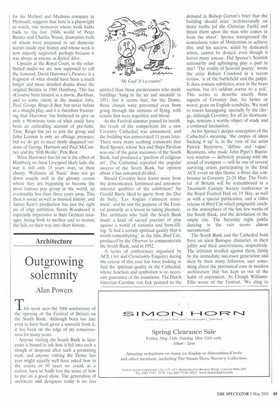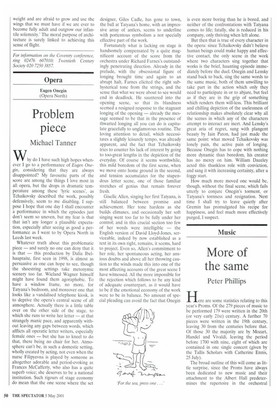Architecture
Outgrowing solemnity
Alan Powers
This week sees the 50th anniversary of the opening of the Festival of Britain on the South Bank. Although born too late even to have been given a souvenir from it, it has been on the edge of my consciousness for many years.
Anyone visiting the South Bank in later years is bound to ask how it fell into such a slough of despond after such a promising start, and anyone visiting the Dome last year might equally well have asked how in the course of 50 years we could, as a nation, have so badly lost the sense of how to put on a good show. The generation of architects and designers today is no less spirited than those predecessors who made buildings 'hang in the air and astonish' in 1951, but it seems that, for the Dome, those chosen were prevented even from going through the motions of flying, with results that were repetitive and literal.
As the Festival summer passed its zenith, the result of the competition for a new Coventry Cathedral was announced, and the building was consecrated 11 years later. There were many scathing comments that Basil Spence, whose Sea and Ships Pavilion was one of the great successes of the South Bank, had produced a 'pavilion of religious art'. The Cathedral repeated the popular success of the South Bank, but opinion about it has remained divided.
Should Coventry have learnt more from the domesticated, feminised and anti-monumental qualities of the exhibition? Sir Gerald Barry liked to quote from the Duc de Sully, 'Les Anglais s'amusent tristement', and he saw the purpose of the Festival primarily as a lesson in taking pleasure. The architects who built the South Bank made a kind of sacred precinct of play against a world of statistics and form-filling. 'It had a certain spiritual quality that is worth remembering,' as the film, Brief City, produced by the Observer to commemorate the South Bank, said in 1952.
A series of conferences organised by ACE (Art and Christianity Enquiry) during the course of this year has been looking to find the spiritual quality in the Cathedral, whose function and symbolism is no necessary guarantee of the numinous. The Dutch historian Caroline van Eck pointed to the demand in Bishop Gorton's brief that the building should seize 'architecturally on those truths [of the Christian Faith] and thrust them upon the man who comes in from the street'. Spence transgressed the iconoclastic rules of Modernism to achieve this, and his success, aided by dedicated artists, cannot be denied, even though it leaves many uneasy. Did Spence's Scottish nationality and upbringing play a part in this? The orality of Scottish poetry,' wrote the critic Robert Crawford in a recent review, 'is of the battlefield and the pulpit. It does contain subtleties, even in the brass section, but it's seldom averse to a yell.' This seems to describe exactly those aspects of Coventry that, for better or worse, grate on English sensibility. We tend to resent haranguing, specially by the clergy, although Coventry, for all its shortcomings, remains a worthy object of study and a continual fascination.
As for Spence's deeper conception of the Cathedral's meaning, 'the corpus of ideas backing it up' is, in the view of the artist Patrick Reyntiens. 'diffuse and vague'. Reyntiens, who made John Piper's Baptistery window — definitely praising with the sound of trumpets — will be one of several surviving artists participating in the final ACE event on this theme, a three day conference at Coventry 21-24 May. The Festival of Britain will be remembered in a Twentieth Century Society conference at the Royal Festival Hall on 19 May, as well as with a special publication, and a video release of Brief City which poignantly catches the atmosphere of the last few weeks of the South Bank, and the desolation of the empty site. The Saturday night public dancing in the rain seems almost sacramental.
The South Bank and the Cathedral both have an alien Baroque character, in their jollity and their assertiveness, respectively. The criticism levelled against them, firstly by the immediate successor generation and then by their many followers, says something about the puritanical core in modern architecture that has kept us out of the habit of enjoyment. As Clough WilliamsEllis wrote of the Festival, 'We cling to weight and are afraid to grow and use the wings that we must have if we are ever to become fully adult and outgrow our infantile solemnity.' The moral purpose of architecture is surely linked to achieving this sense of flight.
For information on the Coventry conference, ring 02476 607010; Twentieth Century Society 020 7250 3857.











































































 Previous page
Previous page